Quick search
CTRL+K
Quick search
CTRL+K

Ghent has a past as one of Europe’s largest cities. It was once the center of Europe’s wool and textile trade, and there was a strong urbanization and industrialization early on. Together with the success of the merchants, it created tremendous wealth, which resulted in, for example, many of the beautiful buildings visitors can see in the city center today.
Cathedrals, churches, monasteries, squares, merchant residences and museums are located in large numbers between the canals in the old town which have retained its medieval character. The large buildings stands next to each other, and the city center is laid out nicely as a continuous open urban space.
One of the finest atmospheres in the city, you will find in the streets of Graslei and Korenlei, which are located along Ghent’s canals. They are the epitome of Flemish canal atmosphere with gabled houses, towers and of course the water. In the two streets there is always a vibrant street life.
The water also makes Ghent an obvious destination for a canal tour, where you see the beautiful city from new perspectives. Graslei and Korenlei are among the places to start sailing, and one of the highlights of the trip is the beautifully preserved castle; Het Gravensteen.
Ghent is also located in the heart of Belgium, and it is a good starting point for visiting other Flemish cultural and merchant cities such as Antwerp, Bruges and Brussels. They are all located a short distance from Ghent and are all full of sights to enjoy.
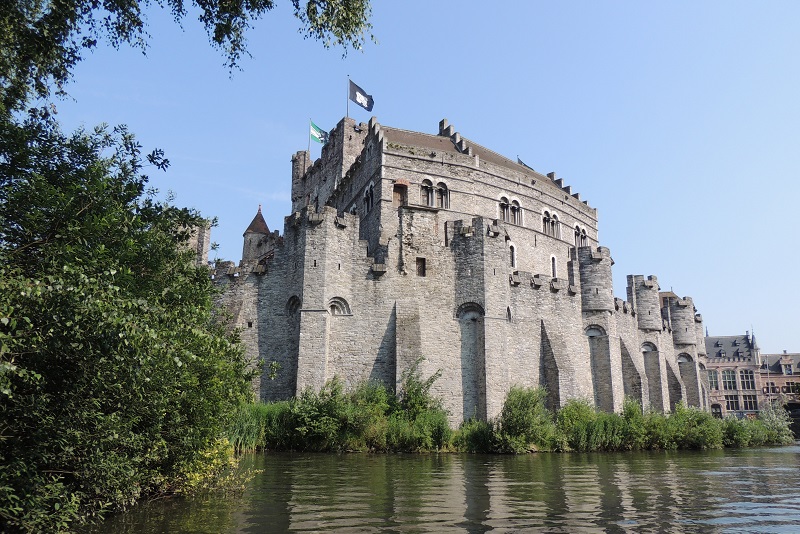
Ghent’s count’s castle was built around the year 1180 by Philip of Alsace, who was count of Flanders. The inspiration has clearly come from the crusader castles that Philip has experienced during his own participation in one of the crusades to the Holy Land.
Before the construction of the current castle, a wooden castle had stood on the same site for more than 300 years. Thus the place had already been a fortified residence for a long time.
Het Gravensteen was the residence of the local counts until the 14th century. Later, a courthouse and prison were set up on the site, and by the end of the 1800s, houses had gradually been built up against the castle walls.
Furthermore, many stones had been used for other purposes, and therefore the castle was in a far from renovated state. The castle was therefore mostly in the way, and it had to be demolished until the city government bought it in 1885. Now Het Gravensteen stands beautifully renovated and rebuilt in the original and very impressive knightly style.
St-Baafskathedraal was originally built in the 9th century, but already less than 100 years later it was expanded, which also happened continuously over the following many centuries. The cathedral is believed to have been completed in 1569, and the style is mainly Gothic. It was named after Saint Bavo/St-Baaf, who is the patron saint of Ghent.
Inside the cathedral you can see the famous altarpiece, Guds Lam/Het Lam Gods, executed 1430-1432 by Jan van Eyck after the overall design of his brother Hubert van Eyck. The work was initiated by the merchant Joost Vijdt, who contested a position equivalent to a mayor.
The altarpiece consists of a total of 12 painted panels in the open state, and there are additional paintings on the outside of the two wings that can close the altarpiece. Het Lam Gods is considered to be among the most significant works from the Middle Ages with the innovative style based on both Gothic, Byzantine and Romanesque inspiration.
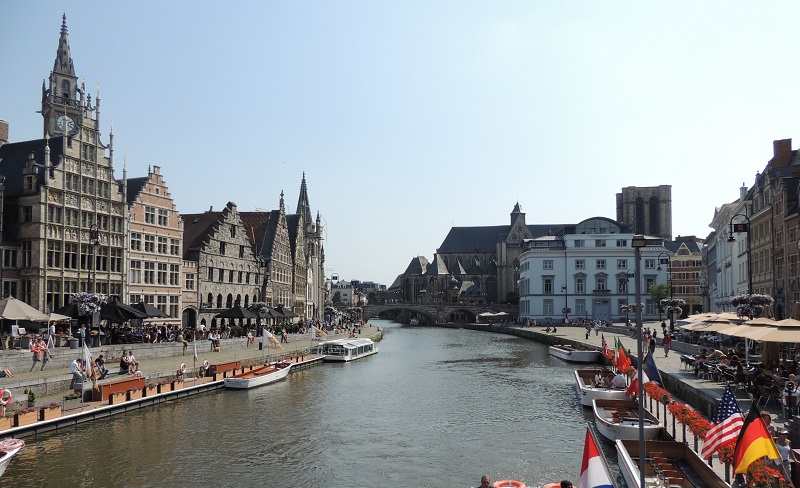
Graslei and Korenlei are the names of two streets along Ghent’s canals. The atmosphere here epitomizes Flemish canal atmosphere with gabled gabled houses, towers and of course the water.
The canal streets Graslei and Korenlei were from the 12th century the port of call for ships that brought mainly grain to the city’s warehouses and markets. Thereby they formed Ghent’s central port.
The best place to get a beautiful overview of the canal and all the houses is from the Sint-Michielsbrug bridge, which since 1909 has connected Graslei and Korenlei to the south. In addition to enjoying the beautiful city space from the bridge or in the streets, you can visit one of the many restaurants or go on a nice canal tour from here.
The canal tour takes you through different eras from Ghent’s rich history, such as the Middle Ages and early industrialization. You also sail to the current end of the canal, which before filling up led to Flemish Bruges.
Het Belfort is Ghent’s 91 meter high bell tower, which was built from 1313 by the city as a symbol of the city’s independence. The tower was completed in 1380, but it has been changed several times since then.
In the lower floor of the tower, the documents for Ghent’s city rights were stored for centuries. One floor up was the living room for the tower staff, who were primarily inferior, marking i.a. the sunset for the townspeople. The next floor is designed as a bell museum.
On the fourth floor is the bell Klokke Roeland, which since 1314 has had to warn the city of enemies in the area. From the next floor, where the tower clockwork is located, there is a very nice view of the city. At the top of the tower is a dragon that symbolizes vigilance as well as Ghent’s strength.
Het Belfort is one of several bell towers in Belgium and France that have been included in UNESCO’s World Heritage List.
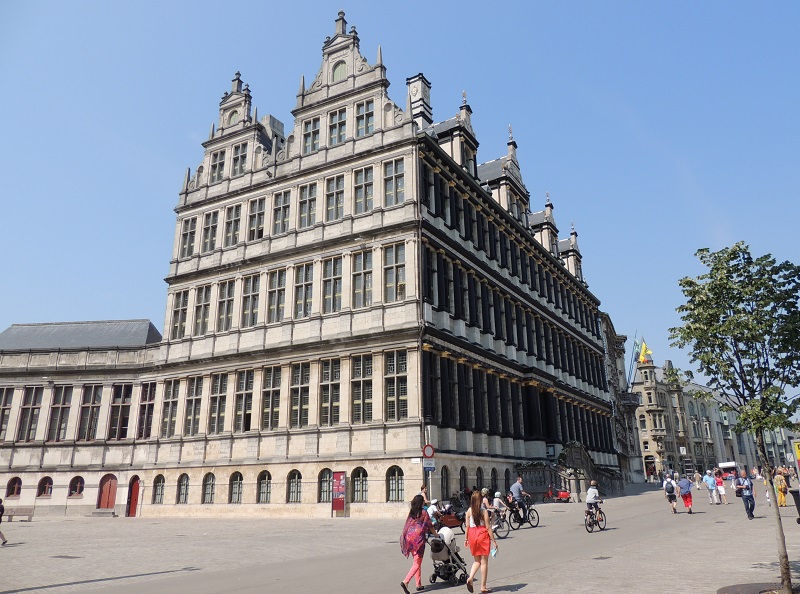
Ghent’s town hall, the Staadhuis, is one of the city’s many buildings worth seeing. The building consists of two wings, which were built in late Gothic 1519-1539 (corner of Botermarkt and Hoogpoort) and Renaissance 1595-1618 (Botermarkt). The newest part is dominated by the rows of columns with Doric, Ionic and Corinthian designs.
Both exterior and interior, different styles are mixed together, and this also applies to many of the town hall’s beautiful rooms and halls. They include the Throne Hall/Troonzaal and the Meeting Hall/Ontvangstsalon, which for a time functioned as a meeting place for the Council of Flanders.
The current St-Niklaaskerk in Ghent was built from the early 13th century on the site where two other church buildings had been located for a few centuries. The church is the best example in Belgium of the country’s so-called Schelde Gothic, which is characterized by the central tower, the corner spires and the use of the blue-grey stones from the area around the city of Doornik/Tournai.
The town’s merchant and artisan shop was located close to the church, which they often used. Therefore, St-Niklaaskerk became the site of their chapels, which were built throughout the 14th and 15th centuries. St-Niklaaskerk was also home to the city’s bells, and that status lasted until the construction of the bell tower Het Belfort in the years 1313-1380.

Groot Vleeshuis means the big meat house or slaughterhouse, and there was also the city’s only meat market from its construction in the years 1407-1419 until the end of the 19th century. The building has been used for various purposes since then, and it is now a market building specializing in regional tourism and the region’s goods.
Lieve is the name of a canal that was dug 1251-1269 as a connection between Ghent and the sea at Zwin near Bruges. It was the first artificial connection to the North Sea; earlier the trip went along the river Scheldt.
Over time, and not least after Zwin’s drying up, the canal lost its importance, and in Ghent today it ends at the tower gate Rabot. Rabot was built after Emperor Maximillian’s siege in 1488 as a fortified defense.
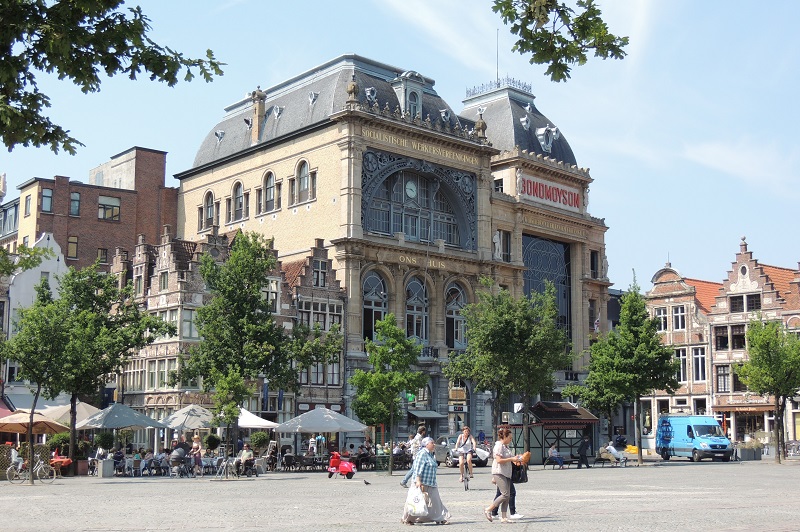
Vrijdagmarkt is one of Ghent’s most beautiful squares. It is surrounded by gabled houses and other buildings, which individually and together create a beautiful whole under the treetops. Over time, the square has also been the city’s welcome place for official visitors as well as a place for political meetings.
Among the houses worth seeing is the 15th-century tower-adorned building Toreken (Vrijdagmarkt 36), which was a low-rise building for the town’s tanners. In the tower is the local market bell. Opposite Toreken stands the monumental People’s House/Ons Huis/Bond Moyson, which dates from the early 1900s.
In the middle of the Vrijdagsmarkt stands a statue of Jacob van Artevelde, who was an industrialist, merchant and statesman in the first half of the 14th century.
At Ghent’s city museum, you can experience the city’s rich history and development over time. This is done through a fine exhibition of archaeological finds, maps and many other effects that give an impression of Ghent.
The city museum’s buildings are also interesting and in themselves part of Ghent’s history. From the 14th century they formed an abbey, which after a few centuries was built into an actual monastery. The cloister corridors and the other parts of the complex today provide space for a chronological tour through Ghent’s development.
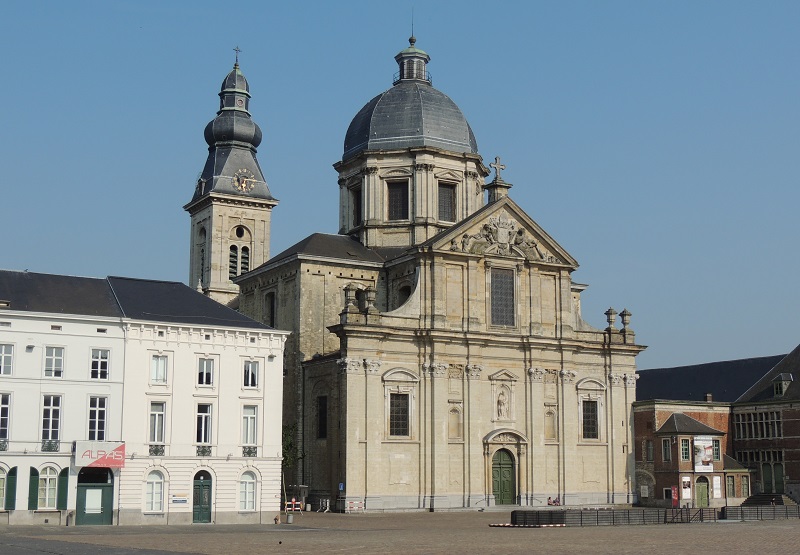
Onze-Lieve-Vrouw-Sint-Pieterskerk is a stately baroque church located on Sint-Pietersplein and on what is the highest point in Ghent at 28 meters above sea level. The current church replaced an earlier church in the Romanesque style, and it was inspired in terms of style by Rome’s many large baroque churches.
The church first functioned as a monastery church with the name Saint Peter’s Church/Sint-Pieterskerk, and close to this was the Onze-Lieve-Vrouwekerk, which the French demolished in 1799 to make way for Sint-Pietersplein. Saint Peter’s Church became the church of Our Lady’s congregation, and thus it got its current name.
This is Ghent’s leading art museum, and here you can experience a fine collection of art from the 14th century to the first half of the 20th century. The central part of the collection is visual art from the southern part of the Netherlands; among others by Baroque masters such as Rubens and Van Dyck. The other European paintings and the sculpture collection are also quite interesting.
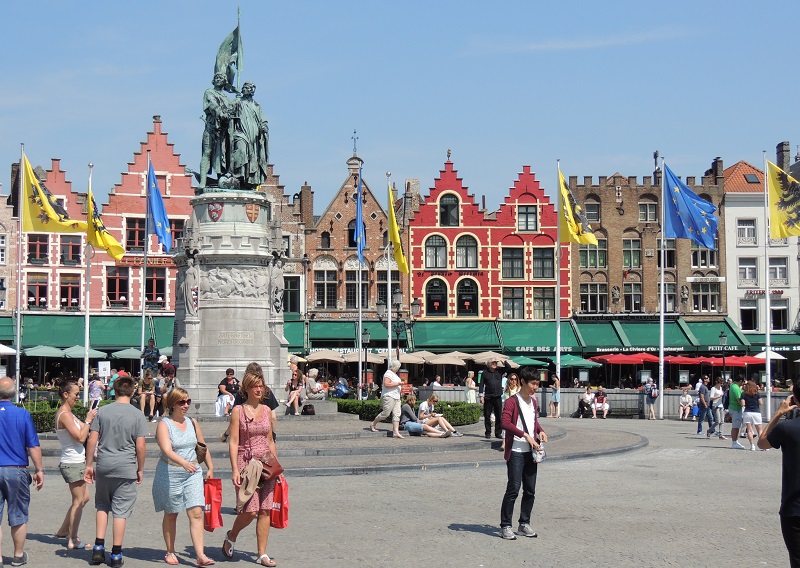
Bruges is one of Europe’s old and rich trading centers, where the fine history of merchants and shipping has created a tourist gem in western Flanders. Here, Flemish urbanization has, over time, gone hand in hand with cultural and economic progress, and the result is so picturesque and interesting with loads of beautiful buildings.
The city’s central squares with Markt and Burg at the forefront are great places to enjoy the the spirit of centuries of architecture. Churches are located at the squares, where the town hall and other famous buildings have been built on the profits of the trade.

Brussels is home to the European Parliament, for many, one of the symbols of the European Union, but the Belgian capital has so much else to offer from its long Flemish history. The city center is Grote Markt / Grand Place, which is considered one of the most beautiful squares in the world.
Only a few minutes walk from Grote Markt, you can see the figure Manneken Pis, the boy who continues to pee after many centuries. And in the old town center there are numerous sights in an easy walking distance from one place to another. Manneken Pis is by the way seen seasonally with different clothes and he always draws many tourists.
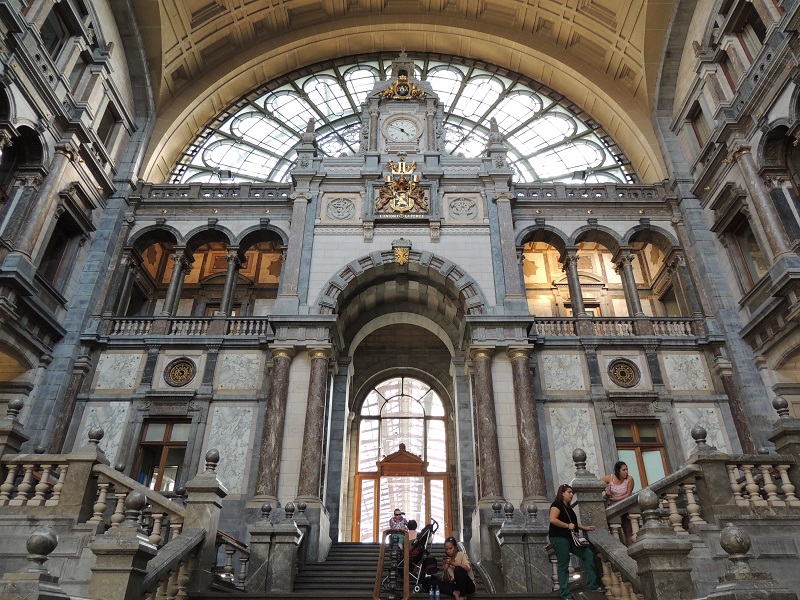
Antwerp is a Flemish metropolis that has become rich after centuries of large-scale trade with the whole world, and it can still be seen today with the city’s activity and busy port. With Antwerp’s strategically good location, it has developed into one of Europe’s largest port citys.
The city center is beautiful and characterized by the wealth that through time made the city’s commercial and religious buildings possible to build. Many areas have richly furnished houses with Grote Markt as the central square. When in town, it is just about exploring central Antwerp and enjoy the fine architecture and atmosphere here.
Woodrow Wilsonplein 4
gentzuid.be
Veldstraat 86
inno.be
Veldstraat, Nederkouter, St.-Niklaasstraat, Voldersstraat, Zonnestraat, Brabantdam, Bennesteeg, Magaleinstraat, Burgstraat
Blaameersen Park, Zuiderlaan 5, www.gent.be/blaarmeersen
De Wereld van Kina
Sint Pietersplein 14
dewereldvankina.be
Settlements in the area where the Leie and Schelde rivers flow together have been inhabited both in the Stone Age and the Iron Age. Some historians also believe that later Ghent got its name from the Celtic word Ganda, which just means confluence.
Archaeological finds have shown that there has also been activity here throughout Roman times, and it was reinforced when the Franks invaded Roman land from the late 300s. With that, old Dutch language and culture were introduced instead of Latin and Celtic.
The history of the city of Ghent dates back to the mid-600s, when St. Amand founded two monasteries on the site; dedicated to St. Peter and St. Bavo respectively. It started the early development of the city, which took place both around the monasteries and in a place where the city’s trade was concentrated.
The city expanded relatively quickly and became a target for the Vikings looting in the 800s. Thus, in 851 and again in 879, the city was attacked by the Scandinavian Vikings, which naturally put a damper on the city’s growth.
In the 1000s Ghent flourished again, and by that time the city grew enormously in the following hundred years, with Flanders being one of Europe’s most urbanized areas.
More than 60,000 people lived within the city walls, and in Europe only Paris was larger. In Ghent, several mighty buildings were erected such as St. Bavo’s Cathedral, St. Nicholas Church and the city’s bell tower.
A significant part of the good economy through the Middle Ages was due to the city’s status as a center for textiles, which for centuries approached several cities in the region. The area around Ghent was particularly good for sheep farming and it provided both production and trade in woolen goods. At one point, the industry was even so developed that wool had to be imported from England to utilize the capacity of the factories.
By the end of the 1300s, Ghent became part of the united Burgundy and Flanders, and slowly but surely the economic dominance of Ghent and Bruges shifted to the cities of Antwerp and Brussels. Ghent maintained some economic strength, but through the 1400s the city’s former strength was also socially and culturally reduced significantly compared to the new centers.
Ghent came under the Spanish rule of the area, and dissatisfaction with that resulted in the Revolt in Ghent in 1539. The revolt was due not least to high taxes going to the Spanish central power. Ghent was conquered, and Spanish king Karl V, born in Ghent, came to the city personally to celebrate the victory by, among other things, letting Ghent’s aristocracy go before him with bare feet and a loop around his neck.
The four-year war broke out in 1568 as the Dutch rebellion against Spanish rule. A transition from 1577 to 1584, Ghent served as a city-state where peace was made between Protestants and Catholics.
The war continued and lasted until 1648, and the end became a division of the Netherlands into a northern Dutch republic and the Spanish Netherlands, under which Ghent belonged. With the split, Ghent’s role in international trade was largely played out, with the city losing its vital access to the sea. A canal to Bruges from 1623 did not compensate for the former primary sea route.
In 1714 Ghent and the Spanish Netherlands had migrated to Austria as a result of the Spanish War of Succession. That status lasted until the peace in Campo Formio, signed October 18, 1797. With the peace agreement, the present Belgium became French.
Political shifts, however, did not affect Ghent’s economic development, which after a few centuries of scattered religious conflicts and some growth really started the textile industry again in the 18th and 19th centuries.
By the end of the 18th century, economic growth was so great that the city attracted many new citizens and industries. Thus, a transition was Ghent the largest city in present-day Belgium.
In 1794, French troops under Napoleon conquered Flanders and thus also Ghent, which during the Napoleonic period attracted more citizens and grew both economically and in population.
On December 28, 1814, the Ghent Treaty was signed in the city. The treaty entered into world history as the agreement that formally ended the war between Britain and the United States.
The following year, the Napoleonic Wars ended and for Ghent it meant that the city became part of the United Netherlands, which was a state formation until the establishment of Belgium in 1830.
The first half of the 19th century was a time of great development in Ghent. The city’s university was founded in 1814, and in the years 1825-1827 new canals were dug between Ghent and Terneuzen by the river Schelde; thereby giving Gent’s textile industry easier access to new markets. 1827 was also the year in which the city erected a gas plant that provided energy for about 700 modern gas lamps in the streets.
The so-called Belgian Revolution in 1830 led to the country of Belgium, which, unlike the Dutch Netherlands, was characterized by a high degree of industrialization, and Ghent was one of the absolute leading cities. At that time the population was around 83,000.
Around 1860, Ghent’s city walls and ramparts were demolished, giving new development as the industry expanded. It created increasing population with many new residential neighborhoods outside the former city center. Thus, the number of urban children reached over 160,000 by the end of the 19th century.
In 1913, a world exhibition was held in Ghent, which for a time became one of the world’s centers. 130 hectares of land gave way to a number of new buildings in the exhibition area and in Ghent itself. Here, the main railway station Gent-Sint-Peters was completed in 1912 as the city’s new gateway for the many travelers.
During both world wars, Ghent was occupied by German troops. Both times, the city escaped through the actions without colossal destruction; During the Second World War, the occupation lasted until September 6, 1944. The Ghent Middle Ages and the many later centuries’ distinguished buildings remained, and they were later continually renovated in favor of tourism.
Today Ghent is a city that welcomes many tourists to its typical Flemish city center with a wonderful atmosphere, where a large part is car-free and therefore a bit more authentic than the other beautiful and historic Flemish cities.
 Het Gravensteen, Ghent[/caption]
Het Gravensteen, Ghent[/caption]
Overview of Ghent
Ghent has a past as one of Europe’s largest cities. It was once the center of Europe’s wool and textile trade, and there was a strong urbanization and industrialization early on. Together with the success of the merchants, it created tremendous wealth, which resulted in, for example, many of the beautiful buildings visitors can see in the city center today.
Cathedrals, churches, monasteries, squares, merchant residences and museums are located in large numbers between the canals in the old town which have retained its medieval character. The large buildings stands next to each other, and the city center is laid out nicely as a continuous open urban space.
One of the finest atmospheres in the city, you will find in the streets of Graslei and Korenlei, which are located along Ghent’s canals. They are the epitome of Flemish canal atmosphere with gabled houses, towers and of course the water. In the two streets there is always a vibrant street life.
About the Whitehorse travel guide
Contents: Tours in the city + tours in the surrounding area
Published: Released soon
Author: Stig Albeck
Publisher: Vamados.com
Language: English
About the travel guide
The Whitehorse travel guide gives you an overview of the sights and activities of the Canadian city. Read about top sights and other sights, and get a tour guide with tour suggestions and detailed descriptions of all the city’s most important churches, monuments, mansions, museums, etc.
Whitehorse is waiting for you, and at vamados.com you can also find cheap flights and great deals on hotels for your trip. You just select your travel dates and then you get flight and accommodation suggestions in and around the city.
Read more about Whitehorse and Canada
Canada Travel Guide: https://vamados.com/canada
City tourism: https://visitwhite-horse.ca
Main Page: https://www.vamados.com/
Buy the travel guide
Click the “Add to Cart” button to purchase the travel guide. After that you will come to the payment, where you enter the purchase and payment information. Upon payment of the travel guide, you will immediately receive a receipt with a link to download your purchase. You can download the travel guide immediately or use the download link in the email later.
Use the travel guide
When you buy the travel guide to Whitehorse you get the book online so you can have it on your phone, tablet or computer – and of course you can choose to print it. Use the maps and tour suggestions and you will have a good and content-rich journey.


Ghent’s town hall, the Staadhuis, is one of the city’s many buildings worth seeing. The building consists of two wings, which were built in late Gothic 1519-1539 (corner of Botermarkt and Hoogpoort) and Renaissance 1595-1618 (Botermarkt). The newest part is dominated by the rows of columns with Doric, Ionic and Corinthian designs.
Both exterior and interior, different styles are mixed together, and this also applies to many of the town hall’s beautiful rooms and halls. They include the Throne Hall/Troonzaal and the Meeting Hall/Ontvangstsalon, which for a time functioned as a meeting place for the Council of Flanders.
The current St-Niklaaskerk in Ghent was built from the early 13th century on the site where two other church buildings had been located for a few centuries. The church is the best example in Belgium of the country’s so-called Schelde Gothic, which is characterized by the central tower, the corner spires and the use of the blue-grey stones from the area around the city of Doornik/Tournai.
The town’s merchant and artisan shop was located close to the church, which they often used. Therefore, St-Niklaaskerk became the site of their chapels, which were built throughout the 14th and 15th centuries. St-Niklaaskerk was also home to the city’s bells, and that status lasted until the construction of the bell tower Het Belfort in the years 1313-1380.

Groot Vleeshuis means the big meat house or slaughterhouse, and there was also the city’s only meat market from its construction in the years 1407-1419 until the end of the 19th century. The building has been used for various purposes since then, and it is now a market building specializing in regional tourism and the region’s goods.
Lieve is the name of a canal that was dug 1251-1269 as a connection between Ghent and the sea at Zwin near Bruges. It was the first artificial connection to the North Sea; earlier the trip went along the river Scheldt.
Over time, and not least after Zwin’s drying up, the canal lost its importance, and in Ghent today it ends at the tower gate Rabot. Rabot was built after Emperor Maximillian’s siege in 1488 as a fortified defense.

Vrijdagmarkt is one of Ghent’s most beautiful squares. It is surrounded by gabled houses and other buildings, which individually and together create a beautiful whole under the treetops. Over time, the square has also been the city’s welcome place for official visitors as well as a place for political meetings.
Among the houses worth seeing is the 15th-century tower-adorned building Toreken (Vrijdagmarkt 36), which was a low-rise building for the town’s tanners. In the tower is the local market bell. Opposite Toreken stands the monumental People’s House/Ons Huis/Bond Moyson, which dates from the early 1900s.
In the middle of the Vrijdagsmarkt stands a statue of Jacob van Artevelde, who was an industrialist, merchant and statesman in the first half of the 14th century.
At Ghent’s city museum, you can experience the city’s rich history and development over time. This is done through a fine exhibition of archaeological finds, maps and many other effects that give an impression of Ghent.
The city museum’s buildings are also interesting and in themselves part of Ghent’s history. From the 14th century they formed an abbey, which after a few centuries was built into an actual monastery. The cloister corridors and the other parts of the complex today provide space for a chronological tour through Ghent’s development.

Onze-Lieve-Vrouw-Sint-Pieterskerk is a stately baroque church located on Sint-Pietersplein and on what is the highest point in Ghent at 28 meters above sea level. The current church replaced an earlier church in the Romanesque style, and it was inspired in terms of style by Rome’s many large baroque churches.
The church first functioned as a monastery church with the name Saint Peter’s Church/Sint-Pieterskerk, and close to this was the Onze-Lieve-Vrouwekerk, which the French demolished in 1799 to make way for Sint-Pietersplein. Saint Peter’s Church became the church of Our Lady’s congregation, and thus it got its current name.
This is Ghent’s leading art museum, and here you can experience a fine collection of art from the 14th century to the first half of the 20th century. The central part of the collection is visual art from the southern part of the Netherlands; among others by Baroque masters such as Rubens and Van Dyck. The other European paintings and the sculpture collection are also quite interesting.
Similar to Ghent Travel Guide
